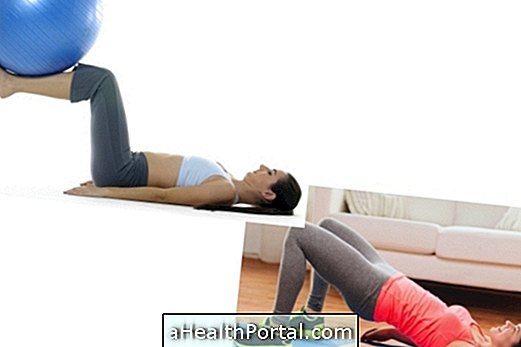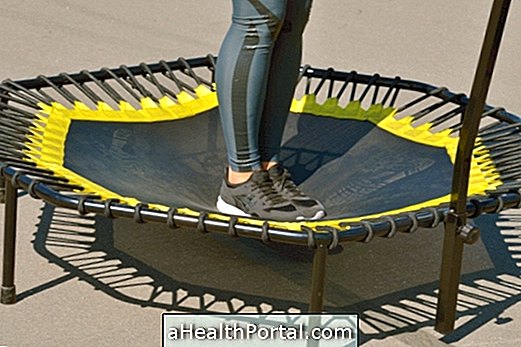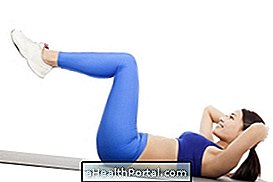Training biceps at home is simple, easy and helps you achieve different goals, from toning up to increasing lean mass and muscle volume.
These exercises can be done without using weights or with weights for faster results. However, it is important to take into account the physical conditions and limitations of the body to avoid any type of injury such as tendon rupture or tendonitis, for example.
The ideal is to do a medical evaluation before starting any physical activity and have guidance from a physical educator who must indicate the weight for each exercise individually.
How to do biceps training at home
Training biceps at home can be done 1 to 3 times a week, in 2 to 3 sets of 8 to 12 repetitions, depending on the exercise. The ideal is to choose 3 to 4 exercises per workout.
Before starting training, warm-up should be done to improve muscle performance, activate circulation and prevent injuries. A good warm-up option is to move your arms several times at a fast pace or do jumping jacks, for example.
Some exercise options for doing a bicep workout at home are:
1. Push-up

Although it is widely used in chest training, arm flexing works with several muscle groups, including the biceps, which allows you to gain mass and stiffen the biceps, especially when you do not have dumbbells or weights at home.
How to do it: lie on your stomach, lift your body by stretching your arms in line with your body, a little more than shoulder width apart, feet on the floor, contracted abdomen and back aligned. Raise and lower your body just by bending and stretching your arms at a 90 degree angle with your elbow. Do not lie on the floor between push-ups. Do the push-ups for 30 seconds, rest for 1 minute and repeat for 2 to 3 sets. If the exercise is very difficult, it is possible to do it with your knees on the floor and, gradually, remove your knees from the floor.
2. Inclined arm flexion

The inclined arm flexion is another variant of the flexion that helps to work the strength and resistance of the biceps, triceps and deltoids. In addition, it helps to strengthen the abdomen and legs.
How to do it: grab a surface to create the slope of your body like Kettle, stool, chair, puff, gym ball or a step exercise platform. Support your hands on the inclined surface, with your arms aligned to your body, a little more than shoulder width and feet on the floor. The body should be straight with the back aligned with the torso. Contract your abdomen, flex your elbows until your chest touches the surface and return to the starting position. You can do 2 to 3 sets of 8 to 10 repetitions each, resting from 60 to 90 seconds between sets.
3. Hammer thread

The hammer hammer exercise is very effective in increasing the volume of the biceps and brachial muscle, but it must be done with the use of weight or dumbbells., If you do not have this type of material, you can place one or more packs of 1kg of rice or beans inside two backpacks or bags from the market, or else use pet bottles with sand inside, for example.
How to do it: standing, hold a weight in each hand with the palm facing inwards, with the arms down aligned to the body. Flex your elbows, raising your forearms until the weights are at shoulder height. It is important to have the abdomen contracted and that the wrists and shoulders do not move, so as not to cause injury. Slowly return your arms to the starting position. Inhale when the arms are in the starting position and exhale when flexing the elbows. You can do 3 to 4 sets of 8 to 12 repetitions each, with 60 to 90 seconds of rest between sets. A variation of this exercise is to alternately raise your arms one at a time.
4. Direct thread

The "barbell curl" exercise is another good option for biceps, as it works strength, endurance, in addition to stimulating the increase in muscle mass and volume. To achieve these goals, weights such as dumbbells, barbells or pet bottles with sand inside, for example, should be used.
How to do it: standing, with feet shoulder-width apart, knees slightly bent and with the abdomen contracted, put the weight in each hand or hold the bar with the elbows bent in front of the body and the hands facing upwards. Without moving your shoulders and with firm fists, raise your arms towards your shoulders and return to the starting position slowly. Inhale when your arms are in the starting position and exhale when you flex your elbows. You can do 3 to 4 sets of 8 to 12 repetitions each, with 60 to 90 seconds of rest between sets.
5. Sitting barbell

The seated barbell is another exercise option for the biceps that also works strength, endurance, increase in muscle mass and volume and you should use dumbbells or a pet bottle with sand inside.
How to do it: sit on a bench or chair with your legs slightly apart and your spine straight. Lean your torso forward and hold the weight, resting your elbow on your leg. The other hand must be supported on the other leg to facilitate the balance of the body. Contract your arm bringing the weight up to your face. Return the arm to the starting position slowly, controlling the descent of the arm. Repeat the movement with each arm 8 to 12 times in 3 to 4 series, resting for 60 to 90 seconds between sets.
6. Forearm plank

Although the forearm plank is an exercise more focused on strengthening the muscles of the abdomen and core, it is also considered a complete exercise, meaning it works on other areas of the body, including the biceps. In this exercise it is not necessary to use weights or dumbbells.
How to do it: lie on your stomach and then raise your body, supporting only your forearms and toes on the floor, always with your abdomen and buttocks contracted and your head and body straight, aligned with your spine. You should stay in this position for as long as possible. You can start with 30 seconds and gradually increase the time. This exercise is not done in series.
What to do after training
After biceps training, stretching should be done to help relax the muscles, tone the muscles, improve flexibility, increase circulation and prevent injuries.
1. Stretch your arms back

Stretching to stretch your arms back should be done standing up to allow you to stretch your biceps, chest muscles, and shoulders well.
How to do it: standing, bring your arms behind your back until your hands meet. Interlace your fingers and raise your arms holding for 20 to 30 seconds. It is important to feel that the biceps are elongated, in addition to respecting the limits of the body
2. Extend your arms

This stretch, allows you to stretch your biceps, chest and spine, and should be done sitting.
How to do it: sit on the floor with your legs straight or bent and your back slightly tilted back on your arms. Do this movement for 30 to 60 seconds.
Was this information helpful?
Yes No
Your opinion is important! Write here how we can improve our text:
Any questions? Click here to be answered.
Email in which you want to receive a reply:
Check the confirmation email we sent you.
Your name:
Reason for visit:
--- Choose your reason --- DiseaseLive betterHelp another personGain knowledge
Are you a health professional?
NoMedicalPharmaceuticalsNurseNutritionistBiomedicalPhysiotherapistBeauticianOther
Bibliography
- GEHM, David G .; CHAOUACHI, Anis. A review of the acute effects of static and dynamic stretching on performance. Eur J Appl Physiol. 111. 11; 2633-2651, 2011

















.jpg)






